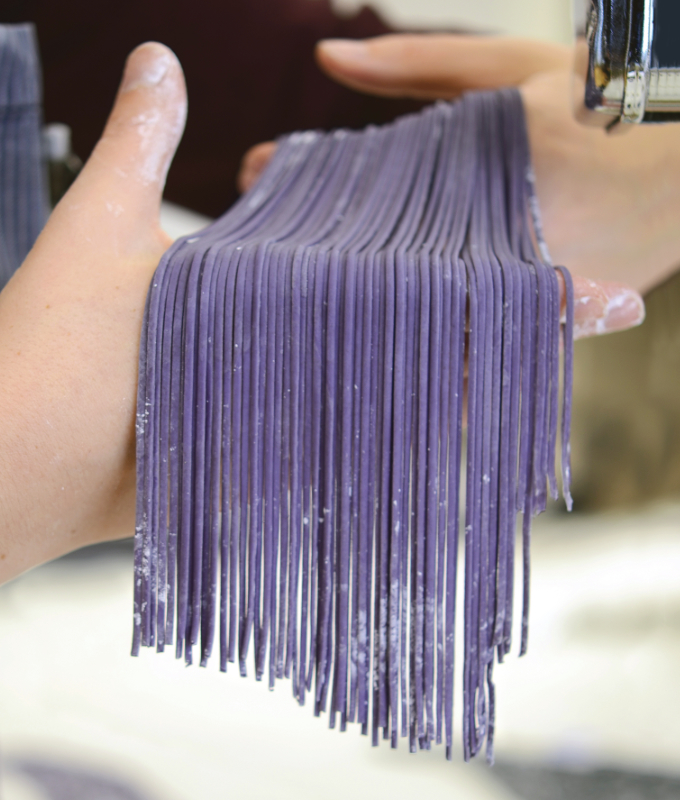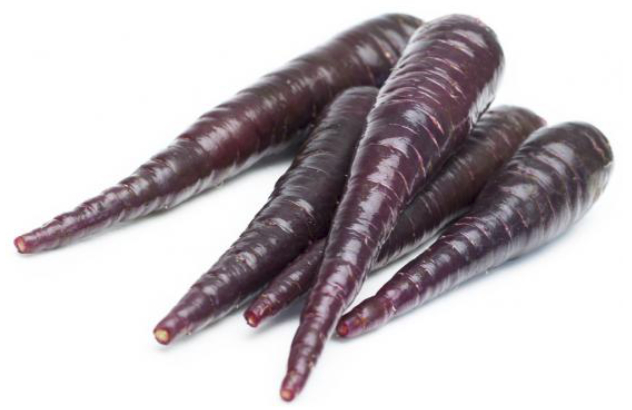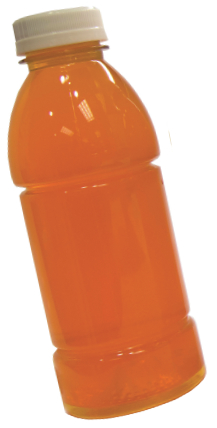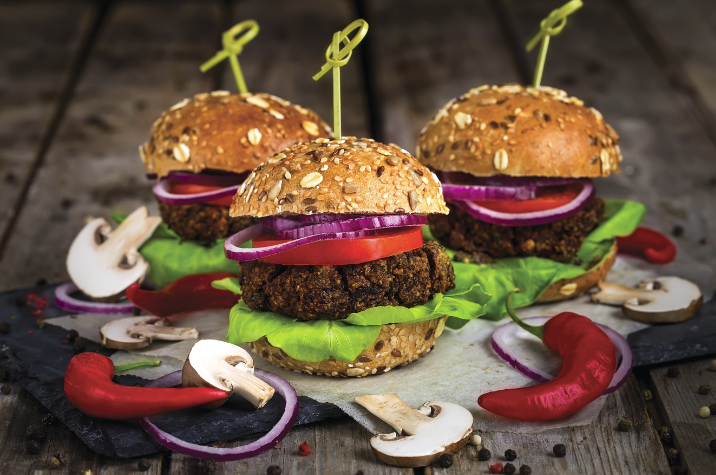KANSAS CITY — Purple may add vibrancy and novelty to items like corn chips, ice cream and pasta. When sourced from certain fruits and vegetables, including corn, the color may add a clean label advantage, and anthocyanins found within the fruits and vegetables may provide health benefits, too.
Ingredient suppliers are offering ways to use purple color’s triple play of benefits.
GNT USA, Inc., Tarrytown, N.Y., uses a variety of different fruits and vegetables to achieve a full range of purple shades, said Michael Serrur, director of communications. The Exberry shade “purple mist” is one example as a selection of carrots are used to achieve a dark purple color.
“The right shade of purple is the perfect way to indicate a grape, blueberry or wild berry flavor, but purple is being tapped more often by manufacturers as a way to bring novel excitement to a broad range of food and beverage applications,” Mr. Serrur said. “Whether we’re looking at an ube (Filipino purple yam) ice cream, raw vegan cheesecake or acai bowls, there’s no shortage of purple food products in the pipeline.”
Purple makes both sweet and savory foods stand out on the plate, said Christina Olivarez, a chef for GNT.
 “I’ve been experimenting with a purple spaghetti colored with Exberry shade purple mist and pairing it within vegetables like roasted cauliflower and spring peas,” she said.
“I’ve been experimenting with a purple spaghetti colored with Exberry shade purple mist and pairing it within vegetables like roasted cauliflower and spring peas,” she said.
Archer Daniels Midland Co., Chicago, also offers ways to achieve purple color. A fruit juice blend, available as both powder and liquid, is water-soluble and works in a pH range of 2.5 to 8. A spirulina blend, available as powder, is water-soluble and works when the pH is under 4.5.
Mr. Serrur said fruits and vegetables get their purple color from a category of flavonoids called anthocyanins.
“While anthocyanins have always been valued for their coloring properties, they are now receiving increased attention from the medical community as potential dietary antioxidants, which have been found to help prevent a range of diseases from diabetes to inflammation,” he said.
The study “Health benefits of purple corn (Zea mays L.) phenolic compounds” was published online Jan. 24, 2017, in Comprehensive Reviews in Food Science and Food Safety. It analyzed the anthocyanins and other potential health benefits of the corn native to the Andes region in South America. The presence of anthocyanins and other phenolic compounds differentiate purple corn from other conventional corn varieties and make purple corn stand out as a health-promoting food.
The purple corn has strong antioxidant capabilities and anti-inflammatory properties, according to the study. It may help to ameliorate lifestyle diseases such as obesity, diabetes, hyperglycemia, hypertension and cardiovascular disease.
 The study involved researchers from The Ohio State University. Alicorp S.A.A., based in Lima, Peru, and the Chinese Scholarship Council Fellowship provided financial support.
The study involved researchers from The Ohio State University. Alicorp S.A.A., based in Lima, Peru, and the Chinese Scholarship Council Fellowship provided financial support.
Healthy Food Ingredients, Fargo, N.D., offers Suntava Purple Corn that may be used in tortilla chips, extruded snacks, cereal, crackers, bread, waffles, pancakes, craft beers and other brewed beverages. The anthocyanins in the purple corn are water-soluble, said Terry Howell, in business development for the Suntava brand. Adding as little as 20% purple corn to many product formulas will create a purple color.
“We recently added a precooked purple corn flake to our line of Suntava Purple Corn ingredients,” Mr. Howell said. “The flakes can be used to add a dash of purple to snacks such as tortilla chips and crackers or as an inclusion or topping for artisan bread. Blend Suntava Purple Corn flakes with steel cut oats and watch the mix turn a bright purple when cooked. Want to add some purple to your soup? These purple corn flakes might be the answer. We have a purple corn ingredient for almost any food or beverage application making it easy for R.&D. and a product development professional to let their imagination run wild.”
D.D. Williamson, Inc., Louisville, Ky., uses a purple corn, too, but to achieve a red color in applications.
“While purple-colored corn could be considered an ancient grain, what’s new is a unique non-G.M. hybrid that stores most of its color in the pericarp,” said Connie Sandusky, Ph.D., global marketing director for D.D. Williamson. “That makes the color easy to extract in warm water and then concentrate to a standard color identity. This simple process translates to simple labels: ‘Colouring food’ in the E.U. and ‘vegetable juice for color’ in the U.S.”
 The corn kernels look purple to the eye, but the extractable color is a vibrant red.
The corn kernels look purple to the eye, but the extractable color is a vibrant red.
“It works exactly the same with common sources such as purple carrot or elderberries to achieve a natural red color,” Dr. Sandusky said. “The vegetable or fruit looks purple, but the extracted color is red.”
The red color from the corn contains a combination of anthocyanins, she said, adding that since many regions of the world may grow corn, the purple corn is scalable.
New systems add orange, yellow colors to beverages
Recent ingredient introductions feature ways to keep orange and yellow colors stable in beverages.
Chr. Hansen, Milwaukee, last year launched two orange color systems and two yellow color systems for beverages.
 The CapColors orange systems use Chr. Hansen’s patented encapsulation technique to improve the functionality of the color in the final application. The systems require that the final application contain a small amount of juice to stabilize the color. The new transparent yellow Colorfruit emulsions offer a color system in both juice and non-juice-based applications. The color offers an alternative to such dyes as tartrazine or sunset yellow.
The CapColors orange systems use Chr. Hansen’s patented encapsulation technique to improve the functionality of the color in the final application. The systems require that the final application contain a small amount of juice to stabilize the color. The new transparent yellow Colorfruit emulsions offer a color system in both juice and non-juice-based applications. The color offers an alternative to such dyes as tartrazine or sunset yellow.
DDW “The Color House,” Louisville, Ky., this year introduced EmulsiTech cloudy paprika to expand its portfolio of liquid color emulsions. EmulsiTech cloudy paprika is stable in typical beverage applications and may be applied in enhanced waters, juice drinks, iced teas and novelty sparkling drinks. EmulsiTech cloudy paprika is non-G.M.O., palm-free and water-dispersible. Paprika oleoresin offers an orange alternative to cochineal extract and F.D. and C. Yellow No. 6.
Colors make meat alternatives more appealing
Plant-based meat alternatives are appearing more often in menus at national restaurant chains and in frozen food sections in retail outlets. Yet before people bite into the texture and judge the flavor of such alternatives, they first may pass judgement on the appearance of the products.
Color comes into play here. Caramel colors are one example as they may assist food companies in passing the “eye test,” or making the plant-based products look more appetizing and more like the typical appearance of meat, according to Sethness Products Co., Skokie, Ill.
Liquid and powdered caramel colors are used often in texturized vegetable protein applications. Since elevated salt levels may be an issue in hydrolyzed vegetable protein applications, Sethness  recommends low sulfite, Class III, positively charged liquid caramel colors.
recommends low sulfite, Class III, positively charged liquid caramel colors.
Color from botanical sources may help plant-based meat alternatives imitate the appearance of ground beef and maintain a simple, vegan ingredient list, according to an October 2017 blog post from Sensient Colors, St. Louis.
Plant-based burgers that are medium rare to medium need a color that withstands the cook/grill process, letting the burger emulate a bloody and juicy appearance. Sensient recommends heat-stable red vegetable juices, including the company’s SupraRed ingredient line.
Plant-based burgers that are medium to medium well done need to emulate the Maillard effect (browning) of cooked meat. Sensient recommends red fruit and vegetable juices dependent on pH.




